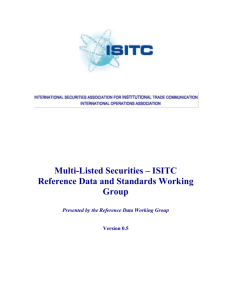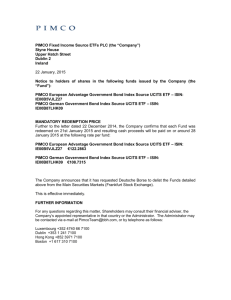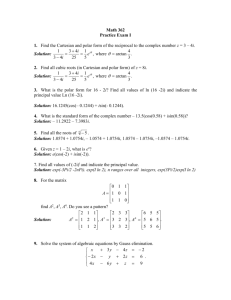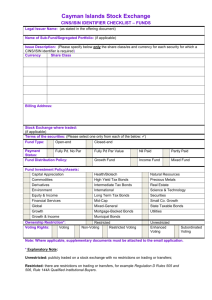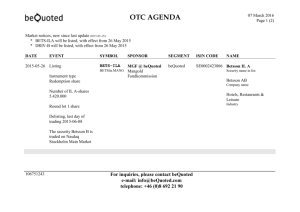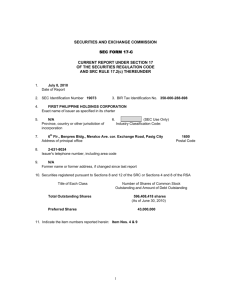ISIN Guidelines 2011 - Association of National Numbering Agencies
advertisement
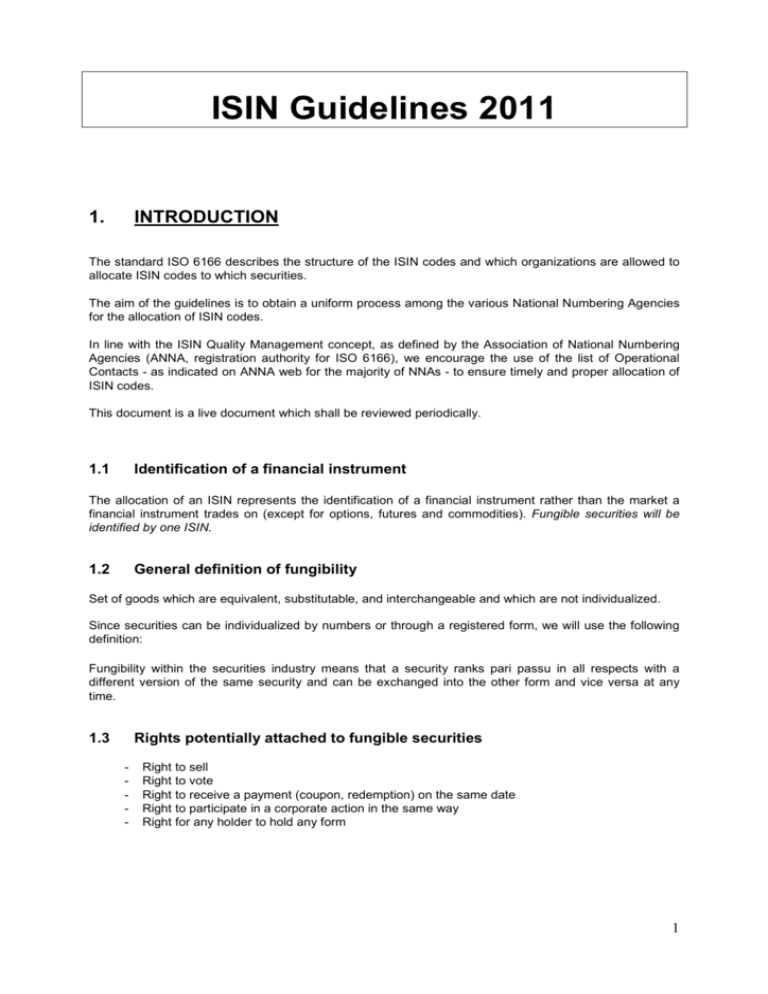
ISIN Guidelines 2011 1. INTRODUCTION The standard ISO 6166 describes the structure of the ISIN codes and which organizations are allowed to allocate ISIN codes to which securities. The aim of the guidelines is to obtain a uniform process among the various National Numbering Agencies for the allocation of ISIN codes. In line with the ISIN Quality Management concept, as defined by the Association of National Numbering Agencies (ANNA, registration authority for ISO 6166), we encourage the use of the list of Operational Contacts - as indicated on ANNA web for the majority of NNAs - to ensure timely and proper allocation of ISIN codes. This document is a live document which shall be reviewed periodically. 1.1 Identification of a financial instrument The allocation of an ISIN represents the identification of a financial instrument rather than the market a financial instrument trades on (except for options, futures and commodities). Fungible securities will be identified by one ISIN. 1.2 General definition of fungibility Set of goods which are equivalent, substitutable, and interchangeable and which are not individualized. Since securities can be individualized by numbers or through a registered form, we will use the following definition: Fungibility within the securities industry means that a security ranks pari passu in all respects with a different version of the same security and can be exchanged into the other form and vice versa at any time. 1.3 Rights potentially attached to fungible securities - Right Right Right Right Right to sell to vote to receive a payment (coupon, redemption) on the same date to participate in a corporate action in the same way for any holder to hold any form 1 2. EXCEPTIONS 2.1 Specific cases relating to fungibility Should the securities be considered as fungible in this case? 2.1.1 Different market places YES, if the security is tradeable in different market places. 2.1.2 Rights difference between different market places in case of corporate action, payment interest/dividends YES, if it is only a technical difference. Technical differences are already managed by depositories and clearing organization for their deliveries. NO, if the securities are lodged in different codes to distinguish the different rights between holders of the various market places. 2.1.3 Subsequent tranches YES, if the securities have identical terms and may be used to settle trades in either tranches, forms or markets without any delay because of possible actions. NO, in other cases until the assimilation. 2.1.4 Securities issued in bearer and/or registered form YES, if the securities are fully exchangeable NO, if the securities are not fully exchangeable 2.1.5 Change of issue from bearer to registered form or from registered to bearer form at the initiative of the issuer NO, if the holder does not have the same rights until the exchange. 2.1.6 Representative certificates YES, in France Euroclear France is allowed to rematerialize French securities to be delivered in some foreign countries. Euroclear France acts in substitution to the issuer and in fact replaces the dematerialized securities by a materialized form. Holders of representative certificates have the same rights as the previous ones. Where share certificates are issued, two general rules will apply: NO, if dematerialized (i.e. German, Swiss, Dutch certificates) or materialized (i.e. IDR, ADR) secondary paper is issued. YES, if no secondary paper is issued. An NNA may assign a "Dummy" (i.e. "Q" range of ISINs) ISIN for use within their local market. 2.1.7 Corporate actions YES, if the securities confer to the new holders the same rights as to the previous ones (e.g. subscription of shares with the same rights as the old shares). NO, if the new shares are not fully exchangeable or if an exchange or a future assimilation is required. Another code permits a distinction between the old and the new securities and the rights attached to those. 2.1.8 Partly paid/fully paid/nil paid NO, until the full payment if an additional payment is required. 2 2.2 Special cases relating to assignment rules 2.2.1 Allocation of ISINs in terms of debt instruments, issued with warrant(s) (i.e.cum or technical cum) Debt instruments cum and ex warrant(s) must be registered separately by the depository bank. Accordingly, the financial instruments should get at least 3 ISINs: - 1 for the debt instrument cum warrant(s) - 1 for the debt instrument ex warrant(s) - 1 for each warrant N.B.: If several kinds of warrants are attached, the number of ISINs assigned increases accordingly. Moreover, all the above ISINs have the same prefix as the one used for the related debt instruments as stipulated in ISO 6166. 2.2.2 Issues composed of both a domestic and an international tranches lf domestic and international tranches are not fungible, then two ISINs should be assigned. Criteria of non-fungibility: transfer restrictions Domestic means: depot in one country upon issuance. 2.2.3 Partial reimbursement of capital when repayment equally to all holders at the same time There is no need to allocate new ISINs, even if the payment effects a change of denomination amount. 2.2.4 Issues with different denominations Shares If different categories of shares were issued, then each value should receive its own ISIN. If certificates consist of multiple of shares, only one ISIN should be assigned. Bonds Only one ISIN for different denominations if fungible. 2.2.5 Taxable/Non-taxable securities Tax considerations may not affect the allocation rules of ISINs, if the securities are fungible. Special case: Different tranches of Italian debt securities subject to pro rata temporis taxation under the provisions of Legislative Decree 239 of 1 April 1996 (LD 239/96) are only fungible, and can only bear the same ISIN, if the issue price, redemption price, issue date and redemption date to be used for tax purposes are identical (e.g. through application of Article 11 (2) of LD 239/96)." 2.2.6 ISINs for rights ISINs should be allocated for rights (according to ISO 6166). 2.2.7 Issues with 2 or more tranches Tranches with different issue prices get different ISINs upon issuance, but have to be assimilated after the first coupon payment. 2.2.8 Warrants issued by foreign branches of banks When such branches have no separate legal entity the ISIN-prefix will be the one of the headquarters country. If the branch is a separate legal entity (i.e. within a specific local market), the country of the branch should be considered for the allocation and the prefix accordingly (e.g. warrants issued by foreign bank branches). 2.2.9 Issues of the European Union Financial instruments issued by the European Union but not relating to a specific EU country jurisdiction (e.g. European indices, European interest rates etc.) would be allocated an ISIN with EU-prefix by WM Datenservice. 3 2.2 Special cases relating to assignment rules continued 2.2.10 Preferred shares Preferred shares issued in unit form (that are being treated as debt) will be assigned the relevant ISIN by the NNA located in the issuer’s country of incorporation and set up as equity. Preferred shares issued in nominal form (that are being treated as debt) will be assigned an XS ISIN (if being held directly with the ICSDs) and set up as bond. Preferred shares that are being treated as equity will be assigned the relevant ISIN by the NNA located in the issuer’s country of incorporation and set up as equity. 2.2.11 RegS/144A debt issues The RegS and/or 144A portion is deposited with a US CSD (only), it will bear the US prefix. The RegS and/or 144A portion is deposited with Euroclear Bank / Clearstream Banking, it will bear an XS-ISIN. In case of a bifurcated structure or split note, a minimum of 2 and maximum of 4 unique ISINs will be allocated by the relevant numbering agency in accordance with the place of deposit as described in Annex A entitled “ISIN allocation rules for debt instruments issued under rule 144A and Regulation S” which forms an integral part of these guidelines. 2.2.12 RegS/144A for warrants When RegS/144A rules apply to warrants they will exceptionally bear a US prefix without reference to the country of the issuer, as this is normally the case for instruments referenced under the category "Rights". 2.2.13 Common investment funds For funds, the issuer country means the country where the fund is registered. If this information is missing or not available at the time of the ISIN allocation, tax implications (i.e. country where tax is paid) would apply as the reference country for allocation of the ISIN. 2.2.14 Depository receipts representing a debt instrument The rules for debt securities have to be applied. 2.2.15 Structured Products Allocation rules relating to Structured Products will be addressed in the th revised (7 ) version of ISO 6166. Currently no consistent application of rules apply: - Euroclear/Clearstream, Spain and Germany currently use the debt rule - UK uses country of incorporation - Switzerland uses the domicile of the Lead Manager 4 2.3 2.3.1 Country specific assignment practices – refer to point 6 ‘Numbering Agencies not in line with Guidelines’ Australia Delisted instruments - A temporary ISIN can be allocated in cases where a security is de-listed from the ASX (Australian Stock Exchange). Re-use of ISIN for warrants – ISIN codes for Australian warrants contain the ASX code for the issuer and characteristics of the instrument type. Re-use can occur after at least 45 business days. 2.3.2 Russia Separate ISIN allocation for new issue of equity shares, with same rights, until they are merged with the principal shares. New shares circulate separately from principal shares for several months and are not fungible during this time. The new shares can be cancelled by the Regulator during this period. Upon confirmation from the regulator, the new shares will rank pari passu and the ISIN for the new shares will be made inactive. 2.3.3 USA Allocate ISIN codes to bank loans. 5 3. FINANCIAL INSTRUMENTS OTHER THAN SECURITIES Example Financial Instruments 3.1 Currencies 3.2 Indexes 3.3 Interest rates The ISIN should bear the prefix of the issuer country in case of single currency. For cross rates, the prefix should correspond to the issuer country of the fixed currency of the ratio. Euro EU0009656420 USD US9117941131 Stock exchange indexes: The allocation of ISINs should occur with the prefix of the domicile of the exchange. Other referential indexes: The allocation of ISINs should occur with the prefix of the country of the calculating agent. FTSE 100 Index GB0001383545 IBEX 35 ES0SI0000005 S&P500 Index US78378X1072 Referential interest rates as defined by term and currency, used in the financial sector and calculated by financial institutions. The ISIN should bear the prefix of the originator's country. 1-Year MIBOR ES0S00000018 12-Month LlBOR GB00B5M93442 ES0SM0032042 3.4 Commodities One ISIN per good and domicile of the exchange, even if several exchanges exist in the same country. The different quality degrees within the same good should not be taken into account. Lampante Olive Oil 3.5 Traded Options Each contract defined by expiration date, option type, strike price, currency and underlying instrument will get an ISIN. The ISIN gets the prefix of the country of the exchange issuing the specific derivative instrument. MEFF ES0A00482836 OPC 06 2012 VTA TEF 16,00 Each contract defined by expiration date, currency and underlying instrument will get an ISIN. The ISIN gets the prefix of the country of the exchange issuing the specific derivative instrument. MEFF FUT 12 2011 BBVA 3.6 Financial Futures 3.7. Contracts for Differences (CfDs) ¹ LIFFE GB00DBYV2Y13 PEARSON CALL OPTION 15/06/12 GBX100 ES0B00017433 TURQUOISE GB00D62FXB42 GAZPROM ADR FUT 15/07/11 USD Each CfD defined by standardized contract specifications and traded on an organised exchange or market place will get an ISIN. The ISIN gets the prefix of the country of the exchange issuing the specific CfD. OTC contracts or tailored CfDs, to fit the client’s need, are excluded from an ISIN allocation. 6 4. CONSEQUENCES OF CORPORATE ACTIONS Event and Definition ISIN rules for paperless securities ISIN rules for physical certificates 4.1 Change of country domicile Domicile of company headquarters changes to another country No change of ISIN for securities A new ISIN only if the old security is already existing. exchanged for a new one. 4.2 Merger Merger by absorption: ISINs of shares of the former ISINs of shares of the former One of the companies companies must become inactive companies must become inactive incorporates the other(s) after a certain period. after a certain period. which legally disappear(s) Merger by amalgamation: The two companies merge to form a new legal entity after a certain period 4.3 Assimilation Event which makes the use of an existing separate ISIN superfluous. For example: full dividend rights for new shares, call of outstanding amount on partly paid shares A new ISIN has to be allocated for the stock of the new company and the former ISINs must become inactive. A new ISIN has to be allocated for the stock of the new company and the former ISINs must become inactive. N.B. In both above cases, for bonds, a new ISIN is created only if the old certificates are exchanged for new ones. The ISIN of the new stock has to become inactive when old and new shares become fungible unless a reuse is planned. 4.4 Redemption Repayment of capital The ISIN has to become inactive debt securities or after redemption date, unless the redeemable shares (fully bonds are in default. redeemed) N.B. For convertible bonds, at the end of the conversion period, when last conversion day is after the maturity. The ISIN of the new stock has to become inactive when old and new shares become fungible unless a reuse is planned. The ISIN has to become inactive after redemption date, unless the bonds are in default. N.B. For convertible bonds, at the end of the conversion period, when last conversion day is after the maturity. 4.5 Bankruptcy Forced liquidation of a company - Full or partial compensation of shareholders/creditors The ISIN has to become inactive The ISIN has to become inactive after deletion of the company in the after deletion of the company in the register of commerce. register of commerce. - Discontinuation of the legal proceedings because of lack of assets The ISIN has to become inactive The ISIN has to become inactive after deletion of the company in the after deletion of the company in the register of commerce. register of commerce. 7 Event and Definition ISIN rules for paperless securities ISIN rules for physical certificates 4.6 Change of share capital Change of issued capital (issued stock) of a company - Increase by issue of additional stocks A new ISIN has only to be allocated A new ISIN has only to be allocated for stocks with different rights. for stocks with different rights. - Increase by change of nominal value The ISIN code remains unchanged A new ISIN is required in case of exchange of the old certificates - Decrease by change of The ISIN code remains unchanged nominal value A new ISIN is required in case of exchange of the old certificates 4.7 Liquidation Voluntary dissolution of a company The ISIN has to become inactive The ISIN has to become inactive after deletion of the company in the after deletion of the company in the register of commerce. register of commerce. 4.8 Change of name For shares: For shares: Renaming of a company The ISIN code remains unchanged A new ISIN is allocated for shares in except in the United States. case of exchange of the old certificates. For debt securities: For debt securities: The ISIN code remains unchanged If the bonds have to be exchanged except in the United States. for new certificates, the ISIN must be changed. 4.9 Stock split Subdivision The ISIN code is changed only if A new ISIN is required in case of necessary for technical reasons exchange of the old certificates 4.10 Reverse split Consolidation The ISIN code is changed only if A new ISIN is required in case of necessary for technical reasons. exchange of the old certificates 4.11 Renewal of coupons Not applicable. No new ISIN will be allocated in such a case provided that the certificate does not need to be exchanged. 8 ISIN rules for physical certificates Event and Definition ISIN rules for paperless securities 4.12 Official stripping Separate trading of registered interest and principal of securities. The ISIN should bear the prefix as The ISIN should bear the prefix as determined by the allocation rules for determined by the allocation rules debt instruments. for debt instruments. In case of official stripping, the issuer designates the underlying issue as eligible for stripping and appoints strip dealers. 4.13 Unofficial stripping Unofficial stripping is generally issued by a Trust or SPV (special purpose vehicle) which repackages the underlying issue without the authorization of the issuer. In this case, evidence of ownership is in the form of a certificate issued by the Trust or the SPV. The certificates are not the primary obligation of the issuer of the underlying security and in the event of default of the Trust or the SPV no claim can be made by certificate holders against assets of the issuer of the underlying bond in order to recoup their principal and interest. The ISIN should bear the prefix of the country in which the entity performing the coupon strip is legally domiciled. The ISIN should bear the prefix of the country in which the entity performing the coupon strip is legally domiciled. 4.14 Change of Primary No change of ISIN for For physical certificates, a new ISIN place of deposit ² paperless/immobilised securities only if the old security is exchanged for a new one. Place of deposit is changed from one (I)CSD to another (I)CSD 9 5. RE-USE OF ISIN CODES As a general rule, ISINs should never be re-used. Where this is unavoidable, such a re-use shall not occur before expiration of a 10-Years-period following the inactivation of the ISIN (e.g. after the maturity date of bonds, or bankruptcy date of the issuer in case of shares for instance). This rule applies to all kinds of financial instruments, except for options, futures and other short term money market instruments for which the re-use may occur one year after the expiration date. 6. NUMBERING AGENCIES NOT IN LINE WITH THE GUIDELINES The Letter of Understanding will govern all ISIN allocations. Should this not be possible for certain events, the long term goal should be to come in line with the guidelines as soon as practical. 7. BANKING INSTRUMENTS/FACILITIES All banking instruments or facilities such as: - Bills for discount - Bank loans - Credit facilities (overdraft, revolving) - Documentary credits - Collection items, etc… are outside of the scope of the ISO-6166 standard and should not be identified by ISIN codes. 8. GLOSSARY OF TERMS ¹ Contracts for differences: A CfD (Contract for Difference) is an agreement between a buyer and a seller to exchange the difference in value of a particular instrument from the moment in which the contract is opened until it is closed. That difference is determined by reference to an ‘underlying’ - a share, index, FX rate or commodity - and the period over which the CfD is held. A CfD is a derivative instrument that allows investors to speculate on the price movements of an underlying without the need for ownership of it. ² Primary Place of Deposit: The primary place of deposit is the securities settlement system which physically holds the securities in custody or, for dematerialised securities, which maintains the official issuance records. 10
